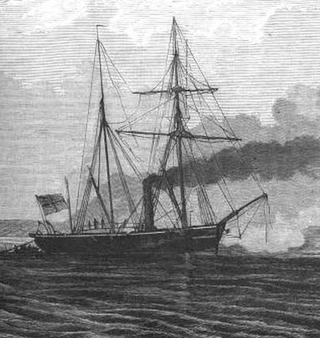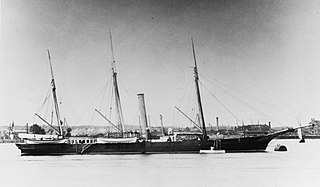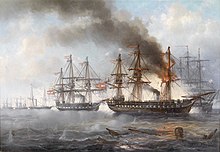
The Battle of Heligoland was fought on 9 May 1864, during the Second Schleswig War, between a Danish squadron led by Commodore Edouard Suenson and a joint Austro-Prussian squadron commanded by the Austrian Commodore Wilhelm von Tegetthoff. The action came about as a result of the Danish blockade of German ports in the North Sea; the Austrians had sent two steam frigates, SMS Schwarzenberg and Radetzky, to reinforce the small Prussian Navy to help break the blockade. After arriving in the North Sea, Tegetthoff joined a Prussian aviso and a pair of gunboats. To oppose him, Suenson had available the steam frigates Niels Juel and Jylland and the corvette Hejmdal.

The naval Battle of Jasmund took place between elements of the Danish and Prussian navies on 17 March 1864 during the Second Schleswig War. The action took place east of the Jasmund peninsula on the Prussian island of Rügen, during a Prussian attempt to weaken the Danish blockade in the Baltic Sea. The Prussian squadron, commanded by Eduard von Jachmann, sortied with a screw frigate, a screw corvette, a paddle steamer, and six gunboats to attack the Danish squadron blockading the eastern Prussian coast. The Danish force was commanded by Edvard van Dockum, and it consisted of one screw frigate, one ship of the line, and two steam corvettes. In an action lasting two hours, the superior Danish squadron forced the Prussians to withdraw, with both sides suffering damage and light casualties. The Danish victory was compounded by the arrival of further warships after the battle, which cemented the blockade. The outcome of the battle, and the naval war in the Baltic as a whole, was irrelevant to the outcome of the war, however, as the Prussian and Austrian armies decisively defeated the Danes on land, forcing them to surrender.

SMS Arminius was an ironclad warship of the Prussian Navy, later the Imperial German Navy. The vessel was a turret ship that was designed by the British Royal Navy Captain Cowper Coles and built by the Samuda Brothers shipyard in Cubitt Town, London as a speculative effort; Prussia purchased the ship during the Second Schleswig War against Denmark, though the vessel was not delivered until after the war. The ship was armed with four 21 cm (8.3 in) guns in a pair of revolving gun turrets amidships. She was named for Arminius, the victor of the Battle of the Teutoburg Forest.

SMS Comet was a Camäleon-class gunboat of the Prussian Navy that was launched in 1860. A small vessel, armed with only three light guns, Comet served during the Second Schleswig War of 1864 and the Franco-Prussian War of 1870–1871, part of the conflicts that unified Germany. The ship was present at, but was only lightly engaged in the Battle of Jasmund during the Second Schleswig War. She served in a variety of roles during peacetime, including fishery protection and survey work. Comet went on one lengthy deployment abroad, with an assignment to the Mediterranean Sea from 1876 to 1879. She saw little active service after returning to Germany and was decommissioned and hulked in 1881. The vessel remained in the navy's inventory until at least 1891, being broken up sometime thereafter.

SMS Basilisk was a Camäleon-class gunboat of the Prussian Navy that was launched in 1862. A small vessel, armed with only three light guns, Basilisk served during all three wars of German unification in the 1860s and early 1870s. The ship was present during the Battle of Heligoland in May 1864 during the Second Schleswig War, but was too slow to engage the Danish squadron. During the Austro-Prussian War of 1866 and the Franco-Prussian War of 1870–1871, Basilisk was stationed in the North Sea to help defend the coast, but she did not see action during either conflict. Between 1873 and 1875, she was employed experimentally as the first torpedo-armed warship of the German fleet. Basilisk was decommissioned in 1875, renamed "Mine Barge No. 1", and converted into a naval mine storage hulk. The details of her fate are unrecorded, but she was still in service in that capacity at least as late as 1900. Sometime thereafter, she was broken up.

SMS Cyclop was a Camäleon-class gunboat of the Prussian Navy that was launched in 1860. A small vessel, armed with only three light guns, Cyclop served during the three wars of German unification; during the first, the Second Schleswig War on 1864, she guarded the Prussian coastline but saw no action. She supported the army's campaign against the Kingdom of Hanover during the Austro-Prussian War of 1866, and she defended the Elbe for the duration of the Franco-Prussian War of 1870–1871, but again took part in no battles. Badly deteriorated by 1872, she was stricken from the naval register in March that year and reconstructed into an iron-hulled gunboat. Recommissioned in 1875, she thereafter served abroad in the German colonial empire before being stricken again in 1888. She was thereafter used as a storage hulk before ultimately being broken up for scrap after 1914.

SMS Delphin was a Camäleon-class gunboat of the Prussian Navy that was launched in 1860. A small vessel, armed with only three light guns, Delphin served during the Second Schleswig War of 1864 and the Austro-Prussian War of 1866, part of the conflicts that unified Germany. The ship was present at, but was only lightly engaged in the Battle of Jasmund during the Second Schleswig War. The ship spent much of the rest of her career in the Mediterranean Sea, going on three lengthy deployments there in 1865–1866, 1867–1870, and 1871–1873. During the last tour, she took part in operations off the coast of Spain with an Anglo-German squadron during the Third Carlist War, where she helped to suppress forces rebelling against the Spanish government. For the rest of the 1870s, she served as a survey vessel in the North and Baltic Seas before being decommissioned in August 1881, stricken from the naval register the following month, and subsequently broken up for scrap.

The Camäleon class was a group of gunboats built for the Prussian Navy. Eight ships comprised the class: Camäleon, Comet, Cyclop, Delphin, Blitz, Basilisk, Meteor, and Drache. The vessels were armed with a battery of one 15 cm (5.9 in) gun and two 12 cm (4.7 in) guns. In 1865, the ships then in service had their 15 cm gun replaced with a 21 cm (8.3 in) gun; Meteor and Drache, not yet completed, entered service with that gun. The vessels saw action during the wars of German unification, with Comet taking part in the Battle of Jasmund and Blitz and Basilisk present during the Battle of Heligoland, both during the Second Schleswig War in 1864. Several of the ships served in the North Sea during the Austro-Prussian War, where some of them supported operations against the Kingdom of Hanover. During the Franco-Prussian War, Meteor battled the French aviso Bouvet in the Battle of Havana in 1870; the other members of the class were deployed on coastal defense assignments.

SMS Nymphe was the lead ship of the Nymphe class of steam corvettes, the first ship of that type to be built for the Prussian Navy. She had one sister ship, Medusa, and the vessels were wooden-hulled ships armed with a battery of sixteen guns. She was ordered as part of a naval expansion program to counter the Danish Navy over the disputed ownership of Schleswig and Holstein. Nymphe was laid down in January 1862, was launched in April 1863, and was completed in October that year.

The Nymphe class of screw corvettes were the first vessels of the type to be built for the Prussian Navy in the early 1860s. The class comprised two vessels, Nymphe and Medusa. The ships were laid down in early 1862, and Nymphe was completed by late 1863, but work on Medusa proceeded slower, owing to budgetary disputes with the Prussian parliament and a desire to use experience in building Nymphe during the former's construction. The ships were built as part of a naval expansion program aimed at countering the powerful Danish Navy in the context of the disputed ownership of Schleswig and Holstein. The ships were armed with a battery of sixteen guns, and were capable of a top speed of 12 knots under steam power. All of the material used in their construction was domestically produced, apart from the propulsion system, which was imported from Great Britain.

SMS Radetzky was a screw frigate in the Austro-Hungarian Navy, built in England in 1856. She was lost after the detonation of her powder magazine in 1869.

SMS Preussischer Adler was a paddle steamer originally built in the mid-1840s for use on a packet route between the Kingdom of Prussia and the Russian Empire in the Baltic Sea. She was requisitioned by the Prussian Navy during the First Schleswig War in 1848 and converted into an aviso, the first vessel of the type commissioned by Prussia. During the war, she took part in an inconclusive action with the Danish brig St. Croix, the first naval battle of the Prussian fleet. After the war, she was disarmed and returned to her commercial role, operating uneventfully on the Stettin–St. Petersburg route until 1862, when the expansion of the Prussian Eastern Railway had rendered the maritime route superfluous. The ship was purchased by the Prussian Navy that year and rearmed, once again as an aviso.

SMS Grille was an aviso of the Prussian Navy built in France in the mid-1850s as part of a naval expansion program directed by Prince Adalbert of Prussia, who saw the need for a stronger fleet. She was authorized in 1855 in the aftermath of the First Schleswig War, which had demonstrated the weakness of the Prussian fleet. Grille was the first screw propeller-driven steamship to be built for Prussia; all earlier steam-powered vessels had been paddle steamers.

SMS Loreley was an aviso of the Prussian Navy built in the late 1850s. Built as a paddle steamer, since the Prussian naval command was not convinced of the reliability of screw propellers, she was the first Prussian warship to be fitted with a domestically-produced marine steam engine. The ship carried a light armament of two 12-pound guns and had a top speed of 10.5 knots. Loreley was intended to serve as the flagship of the gunboat flotillas that formed the bulk of the Prussian fleet in the 1850s.

The Jäger class of steam gunboats was a class of fifteen ships that were built for the Prussian Navy in the late 1850s and early 1860s. The class, which were the first steam gunboats built for the Prussian fleet, comprised the following vessels: Jäger, Crocodill, Fuchs, Hay, Scorpion, Sperber, Hyäne, Habicht, Pfeil, Natter, Schwalbe, Salamander, Wespe, Tiger, and Wolf. They were armed with three guns and were intended to guard the Prussian coast in the shallow waters of the Baltic Sea. They proved to handle poorly in service, and as a result, spent much of their existences laid up ashore. Several of the boats were activated during the Second Schleswig War in 1864, and some took part in a minor battle against Danish warships. Crocodill was scrapped in 1867 due to her poor condition, but the rest of the class remained in the fleet's inventory into the 1870s, when they began to be discarded. Most of the ships served on as storage barges, usually for naval mines, though Jäger and Wolf were both sunk as target ships.

SMS Scorpion was a steam gunboat of the Jäger class built for the Prussian Navy in the late 1850s and early 1860s. The ship was ordered as part of a program to strengthen Prussia's coastal defense forces, then oriented against neighboring Denmark. She was armed with a battery of three guns. The ship saw very little activity during her career. She was activated during the Second Schleswig War against Denmark in 1864, and she saw brief action during the Battle of Jasmund on 17 March. Scorpion was commissioned during the Austro-Prussian War in 1866 and the Franco-Prussian War in 1870, but she did not engage any enemy forces during either conflict. The navy disposed of the ship in 1877 and she was later used as a coal storage barge. Her ultimate fate is unknown.

SMS Salamander was a steam gunboat of the Jäger class built for the Prussian Navy in the late 1850s and early 1860s. The ship was ordered as part of a program to strengthen Prussia's coastal defense forces, then oriented against neighboring Denmark. She was armed with a battery of three guns. The ship saw very little activity during her career. She was activated during the Second Schleswig War against Denmark in 1864 and the Franco-Prussian War in 1870, being used to defend the Prussian coast. During the latter conflict, she was present for a brief action with French ships in the Baltic Sea. She remained in service through 1875, when she was placed in reserve, where she remained until 1878, when she was struck from the naval register. She was thereafter used as a barge.

SMS Tiger was a steam gunboat of the Jäger class built for the Prussian Navy in the late 1850s and early 1860s. The ship was ordered as part of a program to strengthen Prussia's coastal defense forces, then oriented against neighboring Denmark. She was armed with a battery of three guns. The ship saw very little activity during her career. She was activated during the three wars of German unification: the Second Schleswig War against Denmark in 1864. the Austro-Prussian War in 1866, and the Franco-Prussian War in 1870. She saw no action during the first and last conflict, but she took part in operations against the Kingdom of Hanover during the Austro-Prussian War. Tiger served in a variety of roles in the mid-1870s and was eventually discarded in 1877. The ship was thereafter used as a storage barge in Wilhelmshaven. Her ultimate fate is unknown.

SMS Wolf was a steam gunboat of the Jäger class built for the Prussian Navy in the late 1850s and early 1860s. The ship was ordered as part of a program to strengthen Prussia's coastal defense forces, then oriented against neighboring Denmark. She was armed with a battery of three guns. The ship saw very little activity during her career. She was activated during the three wars of German unification: the Second Schleswig War against Denmark in 1864. the Austro-Prussian War in 1866, and the Franco-Prussian War in 1870. She participated in a minor skirmish against Danish forces in the first conflict, and then took part in operations against the Kingdom of Hanover during the Austro-Prussian War. She saw no action during the war with France. Wolf remained in service until mid-1873; she was struck from the naval register in 1875, used as a storage hulk for nearly a decade, before being sunk as a target ship for torpedo tests in 1884. The wreck was then raised and scrapped.











